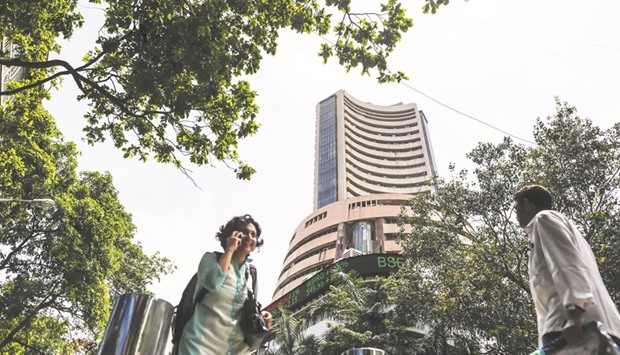Indian stocks reclaimed the 11-month high and an index of medium-sized companies rallied to a record as persistent inflows from overseas investors outweighed investor concern that the rally may have outpaced the outlook for earnings growth.
Maruti Suzuki India, the largest automaker, climbed to a six-month high. State Bank of India and ICICI Bank were among the biggest gainers on the S&P BSE Sensex. Sun Pharmaceutical Industries and Lupin, the top drugmakers, rose to their highest levels in at least three months. Canara Bank was the best performer on the Nifty Midcap Index, which reached an all-time high.
The Sensex added 1.1%, or 292.10 points to 28,095.34 at close, after changing direction 10 times in the first hour of trade. Foreign funds have bought $1.1bn of stocks this month, eclipsing the $771mn inflow in June, as above-normal rain improves the outlook for economic growth and food prices after back-to-back droughts. The bullishness is spreading to the broader market as investors bet smaller companies will benefit the most from expansion in the world’s fastest-growing major economy.
“In an environment of strong global liquidity India will do better than other emerging markets on a relative basis as it is an oasis of growth,” Vikas Gupta, an executive vice president at Arthveda Fund Management in Mumbai, said by phone. “The earnings outlook for small-cap companies is improving and the stocks look cheap on normalised earnings. Smaller equity funds are seeing more value in these stocks.”
Indian equities are tracking gains in emerging-market stocks, which are on course for their best month since March on speculation central banks in Europe and Japan will add stimulus to support their economies in the wake of the UK vote last month to leave the European Union.
Investors pumped more than $2bn into exchange-traded funds that buy emerging market stocks and bonds last week, adding to record gains in the previous period and bringing the current winning streak to more than $10bn.
Still, the rally has pushed the Sensex’s valuation to near a 16-month high, leaving shares with little upside if company earnings lag behind forecasts. June-quarter results from five of eight companies in the gauge that have reported so far have disappointed investors, stoking concern that the 21% jump in the index from a low in February is overdone.
“We don’t see a meaningful growth recovery anytime soon and the earnings estimates are ahead of reality,” Gautam Chhaochharia, head of research at UBS Securities India in Mumbai, said in an interview with Bloomberg TV India yesterday. “The risk reward is unattractive” at current market levels, he said.
Meanwhile the rupee yesterday weakened to over two-week low against the US dollar, as the mood turned cautious ahead of policy meetings of key global central banks, scheduled later this week.
Traders are also cautious as the Constitution amendment bill to amend goods and services tax (GST) is likely to be listed this week, after finance minister Arun Jaitley meets state finance ministers today.
The currency closed at 67.35—a level last seen on July 8—down 0.36%, its steepest fall since June 24, from its previous close of 67.08. The local currency opened at 67.18 a dollar and touched a low of 67.36, a level last seen on July 8.
India’s benchmark Sensex index rose 1.05%, or 292.10 points, to close at 28,095.34. So far this year, it has gained 7.57%.
The US Federal Open Market Committee is due to start a two-day monetary policy meeting on July 26, with the market expecting the US Federal Reserve to keep monetary policy steady.
Traders will also be eyeing Bank of Japan’s two-day monetary policy meeting due to start on July 28, with markets expecting additional fiscal and monetary stimulus to jump-start the country’s anaemic growth.
So far this year, the rupee is down 1.78%, while foreign institutional investors have bought $4.02bn in equity and sold $864.10mn in debt markets.
Asian currencies closed lower. Taiwan dollar was down 0.45%, Indonesian rupiah 0.36%, South Korean won 0.21%, Singapore dollar 0.19%, Thai baht 0.17%, Malaysian ringgit 0.17%, Philippines peso 0.13%, Japanese yen 0.13%, China offshore 0.1%.
The dollar index, which measures the US currency’s strength against major currencies, was trading at 97.339, down 0.13% from its previous close of 97.467.
India’s 10-year bond yield closed at 7.248%—a level last seen on June 7, 2013, compared with Friday’s close of 7.251%. It opened at 7.246% and touched a low of 7.234%, a level last seen on June 7, 2013.

Pedestrians walk past the Bombay Stock Exchange building in Mumbai. The Sensex closed up 292.10 points to 28,095.34 yesterday, after changing direction 10 times in the first hour of trade.
